designing your space
There are as many approaches one can take to design an ecological food garden as there are ecological gardeners. This is the approach I take.
I happen to find the Observation, Vision, and Planning & Development stages just as exciting as Implementation, so I spend a lot of time on this, and I find it saves so much work, money, and frustration later.
This type of gardening generally requires a great deal of patience, especially if you wish to stick to a limited a budget. Also, it will serve you well to let go of control and perfection, as your gardening experience will be much more pleasant.
Designing an entire backyard space can be extremely daunting. Even after reading several books on permaculture and researching various websites, I wasn’t able to find a good source that showed the entire process in pictures. So I hope that this website will serve as such to someone else.
Observation
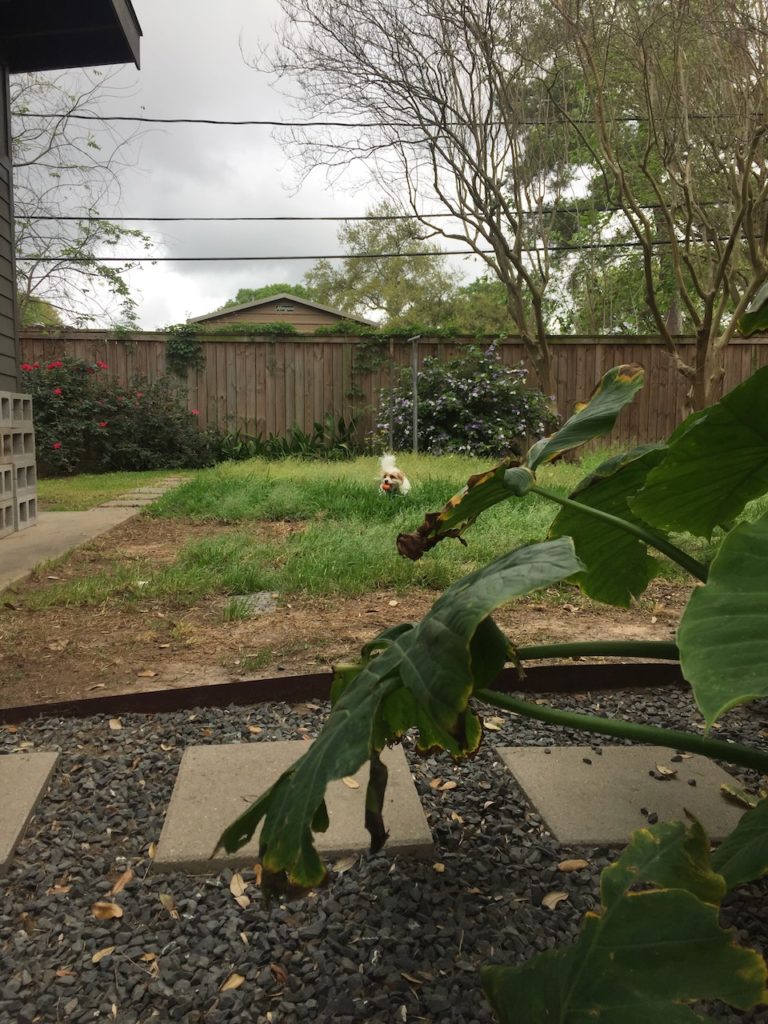
The above photo was my starting point. This is what the backyard looked like when we moved in at the end of February 2020. Patchy St. Augustine mixed with a lot of weeds and bare spots, bushes and lilies against the back fence, and three Crepe Myrtles on and off to the right of the frame.
It’s important to walk your backyard several different times of day, noting your observations. For an urban backyard in Houston, which is what I have, some things to note, with some of my answers, include:
Where does the sun rise?
Where does the sun set?
Note the movement of the sun during the day.
Note the angle of the sun during the different seasons. (This will take a year of observation.)
Identify how much sunlight each area gets:
limited areas in direct sunlight, lots of shade due to numerous trees, including those of neighbors, and especially due to building placement
What kind of soil do you have?
clay gumbo, compacted, no worms
How much rain do you get annually?
average of 54″
When it rains, where does it pool?
blackstar gravel area west side of house, area between Crepe Myrtles, east side of house; sinks reasonably quick, doesn’t drain off
What are your temperature extremes?
100+ in summer; below 20 in winter (wind chill in teens)
What other extremes exist in your region?
flooding, wind (hurricanes/tropical storms)
Are there any trouble spots/unwanted views?
view of the golden arches to the east and a large highway light to the west
What wildlife have you observed?
mosquitoes, flies, squirrels, birds, moths, lizards, geckos, some butterflies, some bats, a frog, a snake
What are your existing or potential resources:
With a magnificent live oak in the front yard, two shared Green Ash trees at the east fence and a pecan in the neighbor’s yard to the west, I have access to an abundance of organic matter in the form of leaves, twigs, and other matter these trees drop, and branches after pruning. Houston gets an average of 54″ of rainfall annually, so that’s another free resource I can harvest. There was a stack of leftover bricks from the building of the house, as well as a black compost bin, some cinder blocks, several 12″ and 18″ square concrete stepping stones, and an old 4×4′ standing planter that I have yet to utilize.
Identify the existing plants, noting what you want to keep and what you want to get rid of:
I planned to keep the Crepe Myrtles, the Canna Lilies, and the Stars and Stripes Lilies. I planned to reduce the St. Augustine; however, after the summer, I decided to phase this out completely, replacing with native buffalo grass and blue grama in sunny areas and little bluestem and sideoats grama in shadier areas. I would dig out the elephant ears, sticky weed, stinging nettle, and english ivy because they are pretty aggressive spreaders, but I would keep the cool-weather pink wood sorrel and warm-weather native basketgrass. I made the decision from here on out to not replace anything that dies due to extreme heat or cold, unless they are edible. Two of the three Knockout Rosebushes didn’t make it through the drought in 2023, so I dug up the remaining one to give to our landlord. (Knockout Rosebushes are one of my least favorite plants.) The Yesterday, Today, and Tomorrow Bush also finally died after the series of freezes in the last few years and the drought. It’s a beautiful shrub, though highly toxic to dogs, so I didn’t replant.
Vision
The vision stage is where you can daydream about your future backyard:
What do I want the space to look and feel like?
sanctuary, abundance, resilient, wild but neat, soft edges
How do you want the space to function?
closed, self-sustaining system that utilizes free resources (sun, rain, organic matter) and improves fertility and soil structure and supports wildlife, who, in turn, provide further free resources
How much time and energy and money do I have to spend?
several hours a week, at least 20-60 minutes per day; however, I want to work toward it being able to take care of itself for a week, if we go on vacation; I want to spend the least amount possible while still purchasing high-quality, well-designed items where necessary
What do I want to see when I look out of my windows?
Next I will define the things I wish to have for my husband and I, our small dogs, and the wildlife.
For humans:
- Relaxation area
- Night-blooming/fragrance garden
- Grill area
- Paths to walk
- Food gardens
- Herb/salad greens bed
- Vegetable bed/s
- Hugelkultur potato bed
- Herb spiral
- Fruit tree guilds
- Bamboo stand for harvesting garden stakes
- Trellised vine shading west-facing kitchen window in summer
For dogs:
- Grass area to run and sun
For wildlife:
- Habitat pond
- Bird area
- Brush pile
- Native trees, shrubs, vines, plants, groundcover
Planning & Development
Take the things you want to include in your vision, guided by your observations, and begin researching them more in depth.
My vision was to include a herb and vegetable garden, along with mostly native plants, and I wanted to have a night-blooming fragrant area. Therefore, I began to compile a spreadsheet of all the herbs, vegetables, and plants I wanted to include (and the existing plants I would keep), noting their habits, needs, and functions. In this spreadsheet I also listed all of the trees, shrubs, vines, and groundcover. The idea is to have a diverse mix in which a majority of plants have multiple functions, plants suited to your yard’s microclimates, and flowering plants that will bloom year round.
I knew I wanted to build an attractive 3×6′ raised bed over our concrete patio, which is mostly where we hang out outside, and we see it all the time from the kitchen windows. It made sense to locate the night-blooming, fragrance garden here as well, which would all be planted in containers. The house doesn’t have gutters, so I am limited where my 55 gallon rain barrels would go. What made sense was an inner corner just outside the kitchen window where the rain drains off the roof. This would also limit some of the erosion caused from the rain pouring off. I would later daisy-chain another rain barrel to the side of the main one catching water to catch the excess water, which drains through a hose into my pond.
For the pond, I would need to purchase pond liner and large river rock to line the edges. I didn’t like the idea of using plastic, but with a pond of this size, it’s kind of your only option.
For the 4×8′ raised vegetable bed that would go over the ground, I wanted to construct it as cheaply as possible.
For the leaf compost area, I would simply make a big pile on the ground. Eventually I constructed a 4×4′ bin out of 4 fence stakes and some hardware cloth leftover from my 3×6′ raised bed.
Wildlife I want to encourage include: frogs, toads, lizards/geckos, salamanders/newts, snakes, birds, bees, beneficial insects, butterflies, moths, bats, and owls. For this, I will research and note what each of these specifically need: water, food, cover, and places to raise young.
For the unwanted views, I may plant a bamboo stand, in the ground or in a galvanized water trough, that would cover the unwanted views, and I could harvest the bamboo for garden stakes. Additionally, the one planted to hide the unwanted western view could also cool the western kitchen window in the summer. On the other hand, if I did this to hide the unwanted eastern view, it would block more needed sunlight in the east section of the yard.
Now on to zones. Permaculture divides land into zones, guiding where you want to locate each of your elements/areas. In a typical urban yard, you probably won’t go beyond Zone 2, but I’ll list all zones below.
- Zone 1: zone of self-reliance, it requires the most intensive use and care; this is the zone just outside your door; you’ll want to locate elements that you access daily (like an herb and salad garden) or need daily attention; your patio or deck and container plants would be located here
- Zone 2: domestic production zone, it is semi-intensely cultivated; this would include a vegetable bed that requires less attention and harvesting; bird, insect, and wildlife habitat would be located here, as well as your native shrubs and trees (guilded with insectary plants and plants that add fertility) that don’t require daily attention
- Zone 3: farm zone
- Zone 4: forage zone
- Zone 5: unmanaged wilderness
Then you’ll want to plan out your paths. Notice where your paths are now. Does it make sense to continue to utilize these in your plans or will you need to create new ones that make more sense and limit the square footage you use for paths to have more planting space? As for the width of the path, you’ll want to consider access for yourself and for a wheelbarrow/cart for compost and mulch, if necessary.
Because our yard and the neighbors’ yards have several mature tree that provide lots of organic matter (and protection against the scolding sun in summer), I have a great head start on creating soil fertility and structure. Hopefully this means my garden will experience the “pop” that ecological gardeners describe in 3 years as opposed to 5 years.
My husband and I rent, but we have the best landlord, whom we’re been friends with for years. My next step was approving my plan with him, and fortunately he was all on board!
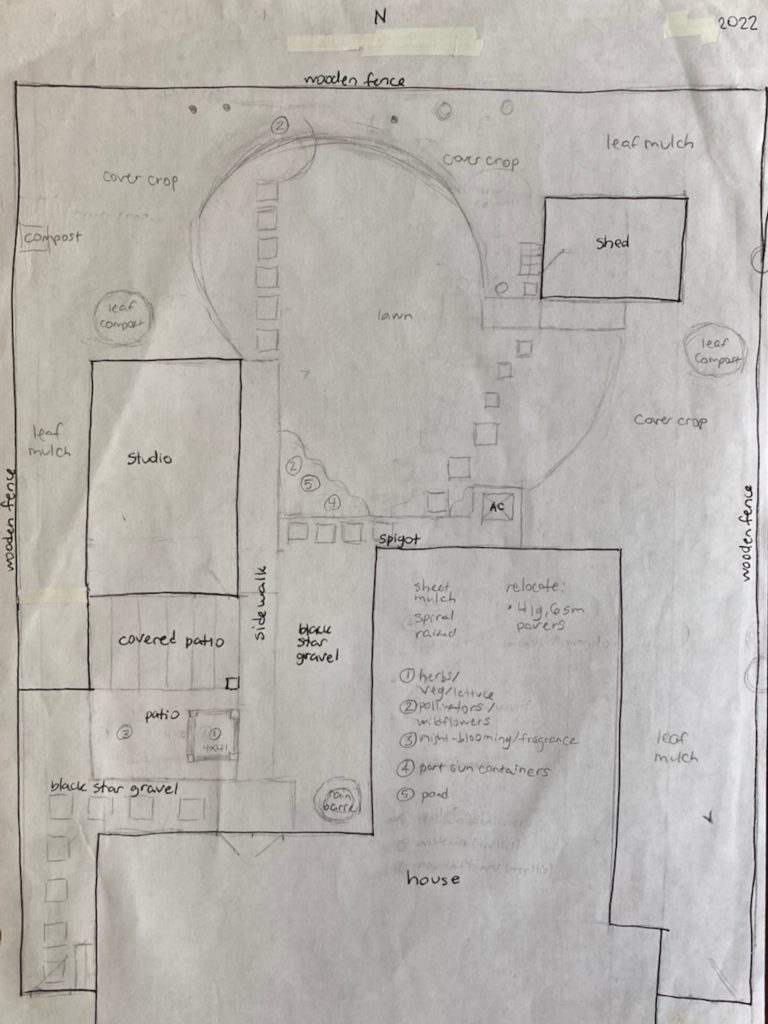
2022 initial sketch
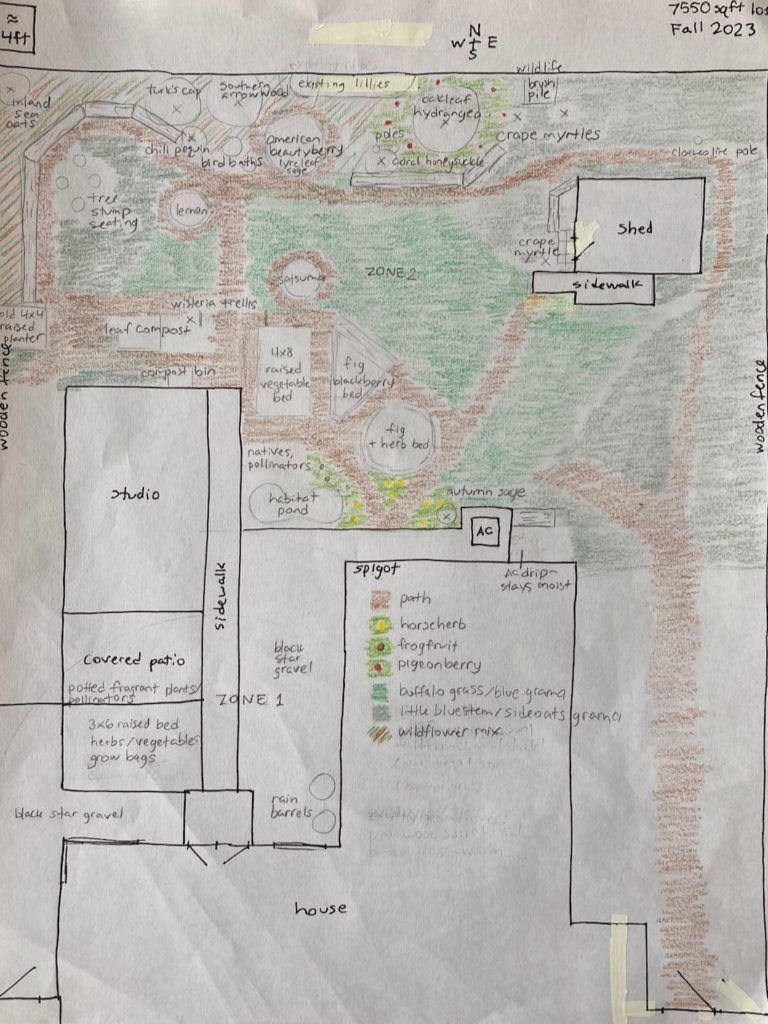
november 2023 sketch
Shortly after I finished the November sketch, I began thinking about my Spring projects, so this sketch will get revised again, but that’s the fun, dynamic nature of the ecological garden: it’s always evolving!
Implementation
I divided up my master plan into a series of projects, which is called “chunking”. A guideline on the order of your projects could look like this:
- Set up your compost bin, leaf compost pile, and rain barrels
- Start with Zone 1 projects, then move to Zone 2 and so on
- Start with projects that will provide the most impact
- Start with projects that will take the longest time to get established, like trees
- Choose projects that make sense for the season you are currently in
- Connect this net of elements, filling in the blank space with native ground cover
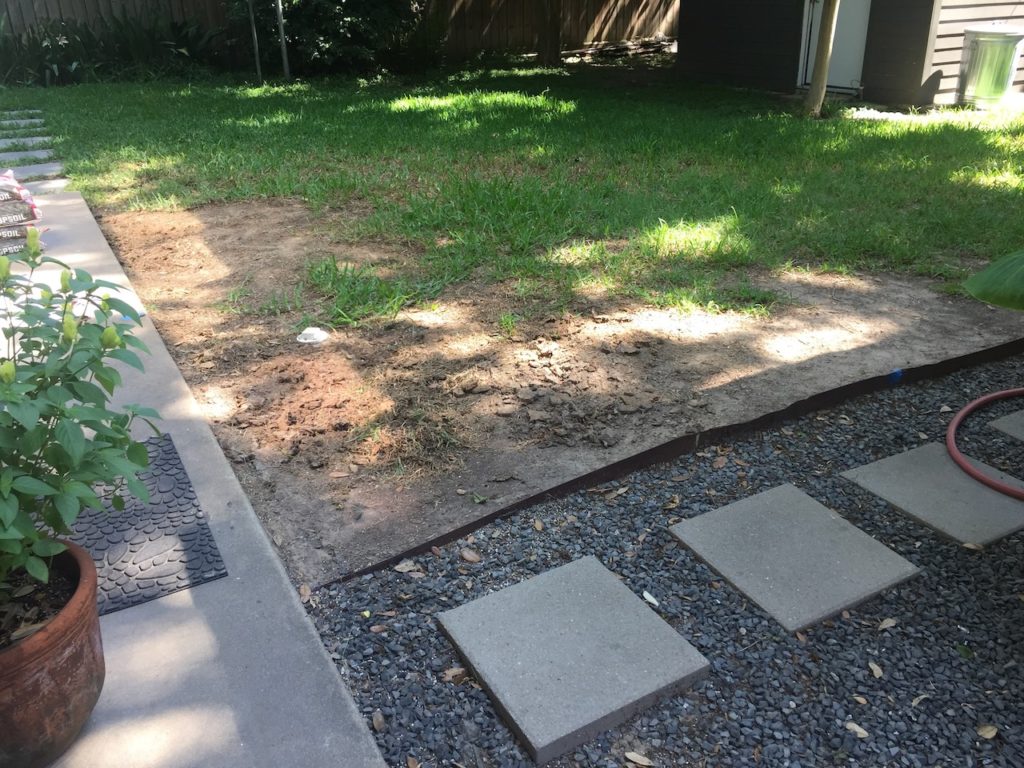
march 2020
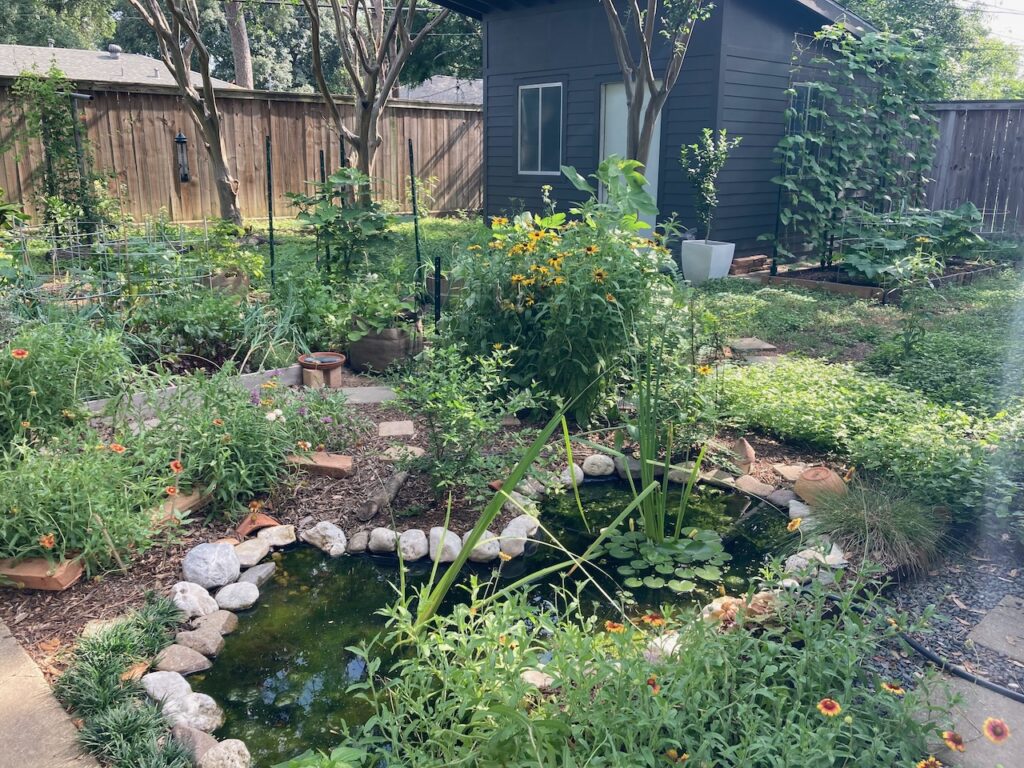
may 2024
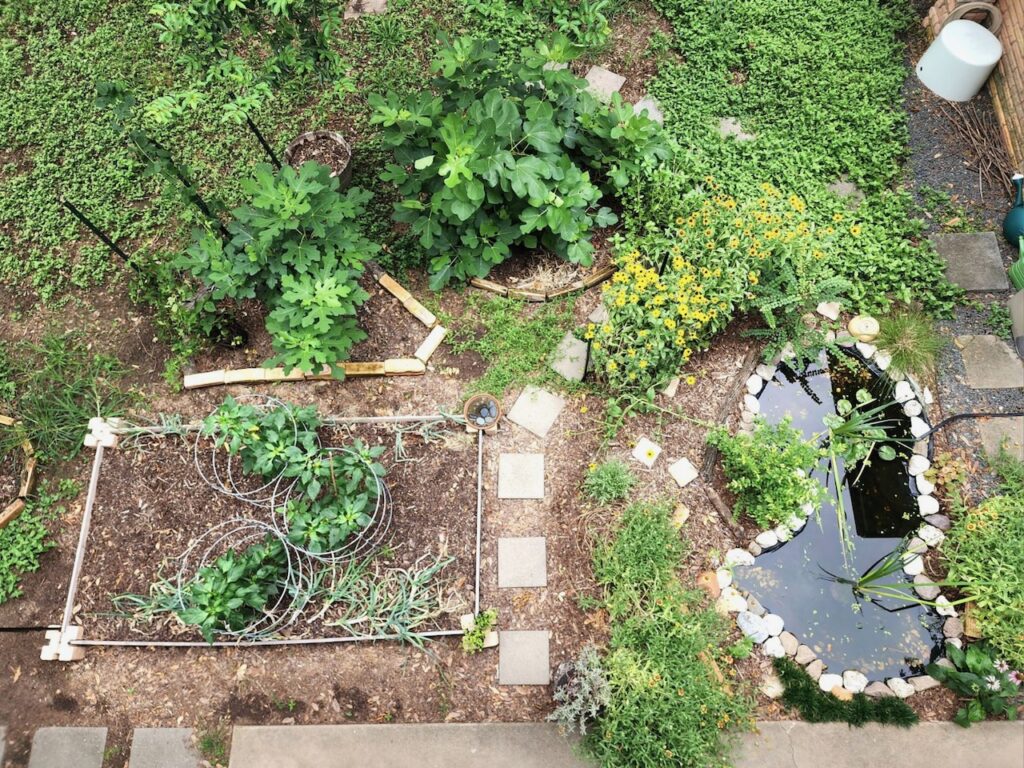
june 2024 aerial view
